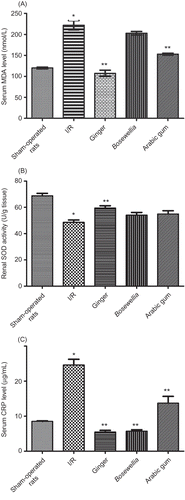Figures & data
Table 1. Effect of oral administration 3 days before and 8 weeks concurrent with adenine (200 mg/kg) on renal function parameters and LDH activity in adult male albino rats.
Table 2. Effect of oral administration 7 days before 30 min ischemia and 24 h reperfusion (IR) on renal function parameters and LDH activity in adult male albino rats.
Figure 1. Effect of oral administration of Boswellia (900 mg/kg), ginger (500 mg/kg), and Arabic gum (200 mg/kg) 3 days before and 8 weeks concurrent with adenine (200 mg/kg) on serum MDA levels (A), renal SOD (B), and serum CRP levels (C) in adult male albino rats.
Notes: MDA, malondialdehyde; SOD, superoxide dismutase; CRP, C-reactive protein.
*Significantly different from control at p < 0.05; **significantly different from adenine group at p < 0.05.

Figure 2. Effect of oral administration of Boswellia (900mg/kg), ginger (500 mg/kg), and Arabic gum (200 mg/kg) for 7 days before RIR on serum MDA levels (A), renal SOD (B), and serum CRP levels (C) in adult male albino rats.
Notes: I/R, ischemia–reperfusion; MDA, malondialdehyde; SOD, superoxide dismutase; CRP, C-reactive protein.
*Significantly different from sham-operated rats at p < 0.05; **significantly different from ischemic–reperfusion (IR) group at p< 0.05.

Figure 3. (A) Electron micrograph of normal rat kidney with normal ultrastructure of proximal tubules, cells with many electron-dense granules, apical vacuolations, and normal-shaped nuclei with apical microvilli and basal enfolding full of mitochondria (arrows); (B) electron micrograph of rat kidney treated with adenine with ultrastructural heterogeneity within proximal tubules, loss of microvilli, some cells show electron-dense cytoplasm, and few mitochondria (arrows); (C) electron micrograph of rat kidney treated with ginger with relatively normal proximal tubules, blood capillaries, corrugated basement membrane, wide capillary spaces, and electron-dense nuclei of blood vessels with irregular-shaped nuclei. There is increase in mesangial cells. The podocytes show dark cytoplasm with dark nuclei (arrows); (D) electron micrograph of rat kidney treated with Boswellia, showing ultrastructural damage within proximal tubules, very few electron-dense granules, and irregular-shaped nuclei of some cells; and (E) electron micrograph of rat kidney treated with AG, showing an improvement of proximal tubules, wide intercellular spaces, corrugated nuclei, thickened basement membrane, and few electron-dense granules (arrows).
Note: AG, Arabic gum.

